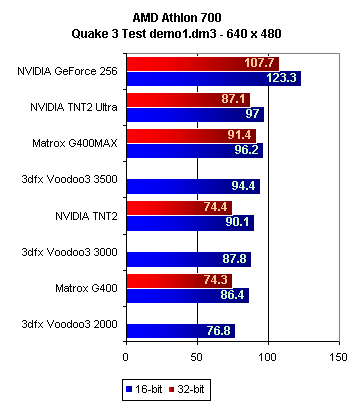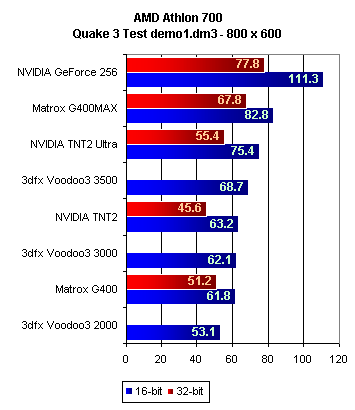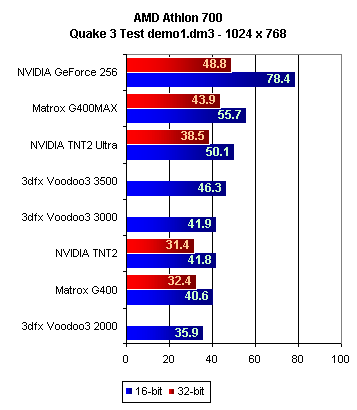AMD Athlon Buyer's Guide - Part 3: Video Cards
by Anand Lal Shimpi on November 11, 1999 10:01 PM EST- Posted in
- Guides

At 640 x 480 the strain on the video card is minimal and the performance is generally dependent on the power of the CPU and how well the drivers for the cards are written. The GeForce 256 obviously comes out on top, a trend which you will see throughout this article simply because it is the faster chip, but the rest of the competitors perform very close to each other.
One thing to note is that in 16-bit color the TNT2 Ultra is faster than the G400MAX, but once you make the move to 32-bit color, which consumes considerably more memory, the 200MHz memory frequency of the G400MAX gives it the slight edge over the 183MHz memory frequency of the TNT2 Ultra. The performance difference isn't huge, but it's a point you'll see repeated as we go through the tests.
The performance all of these solutions offer is more than respectable, but then again, you don't buy an Athlon 700 just to run Quake 3 at 640 x 480. So let's take a look at what happens when you bump up the resolution to 800 x 600.

Here we start to see some of the effects of the limits of the video card. Matrox's TurboGL driver built into the 5.30.007 drivers help push the G400MAX slightly above the TNT2 Ultra in board 16 and 32-bit rendering scenarios. All of the competitors offer above average performance, but it should be noted that the switch to 32-bit rendering leaves only two of the eight cards above the 60 fps mark.
On the lower end of the graph, the performance difference between the G400, Voodoo3 3000 and TNT2 are all very similar. Don't let the numbers fool you, chances are you wouldn't be able to tell the performance difference between those three contenders. The reason that all of the cards perform within a reasonable margin of one another is partially because of the fact that we're testing on such a fast processor.

At 1024 x 768 (especially in 32-bit color) we finally see some real limits of the cards. The performance of the GeForce is incredible in comparison to the rest of the competitors; however, once we make the move to 32-bit rendering the performance drops to just about 5 fps faster than the Matrox G400MAX. Increasing the CPU speed won't help performance too much here, as the limit is primarily the video card. Increasing the core clock speed of the graphics card is the only way to improve performance significantly at this great of a resolution in Quake 3. At the same time, overclocking the memory frequency of the card is the only real way to make a significant improvement in the 32-bit color tests.










2 Comments
View All Comments
care205 - Monday, May 26, 2014 - link
http://ggggggggggg.us">wwwwwwwwwwww
care205 - Monday, May 26, 2014 - link
<a href="http://ggggggggg.us">wwwwwwwww</a>